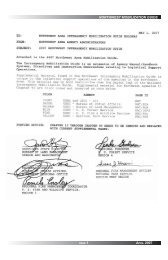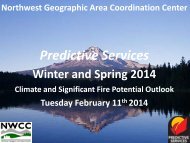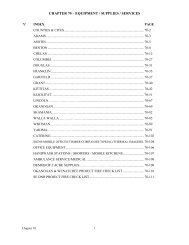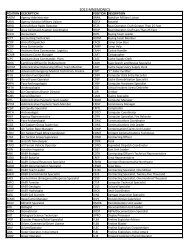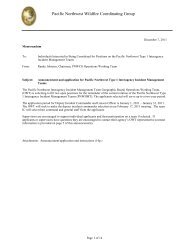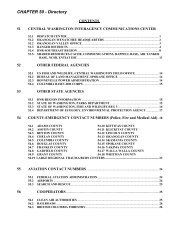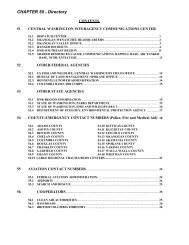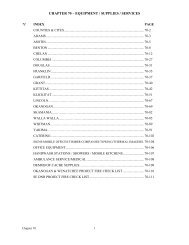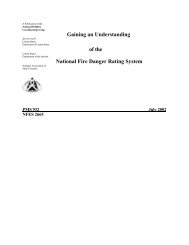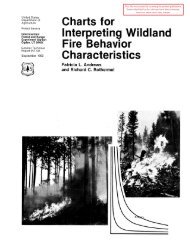Cold Springs Fire - NWCC
Cold Springs Fire - NWCC
Cold Springs Fire - NWCC
You also want an ePaper? Increase the reach of your titles
YUMPU automatically turns print PDFs into web optimized ePapers that Google loves.
<strong>Cold</strong> <strong>Springs</strong> <strong>Fire</strong>Long Term Suppression StrategyandImplementation PlanJuly 22, 2008
<strong>Cold</strong> <strong>Springs</strong> <strong>Fire</strong> Long Term Suppression Strategy andImplementation PlanPurpose and Objectives…………………………………………………..3<strong>Fire</strong> Ecology and History for Mt Adams District…..…………….……4<strong>Cold</strong> <strong>Springs</strong> <strong>Fire</strong> Narrative……………………………………………...4Summary of the <strong>Fire</strong> Risk Assessment………………………………..5Identified Values………………….………………………………….…….6Validation……………………………………………………………….…...6Communication Plan………………………………………………….…..6Administrative Issues and Mitigation Actions………………….……6Management Action Points……………………………………….……..8Monitoring…………………………………………………………..………8Incident Management Organization…………………………….………9Cost………………………………………………………………….……..10Recommendations and Signatures…………………………….........10Appendix A: Management Action Points (MAP)Appendix B: Weather/<strong>Fire</strong> Behavior PredictionsAppendix C: Communications StrategyAppendix D: Proposed Team OrganizationAppendix E: Wildland <strong>Fire</strong> Relative Risk AssessmentAppendix F: <strong>Fire</strong> History and Ecological AnalysisAppendix G: Worst Case Scenario PlanningAppendix I: Cost DataLTP TeamCurtis Heaton (NIMO Lead) Bill Aney (<strong>Fire</strong> Behavior/Long Term Analyst)Mike Matarrese (Operations/SME) Steve Harbert (<strong>Fire</strong> Behavior/Long Term Analyst)Chris Strebig (Information) Jessica Hudec (<strong>Fire</strong> Ecologist)2
Long Term Suppression Strategy and Implementation PlanPurpose and ObjectivesThe purpose of the Long Term Suppression Strategy and Implementation Plan (LTP) is to assistin the long-term management of the <strong>Cold</strong> <strong>Springs</strong> <strong>Fire</strong>. The fire is currently 7,956 acres andburning on private, state, tribal and federal lands. This plan builds upon the leader’s intent of theagency administrators from the Yakama Nation, Bureau of Indian Affairs (BIA), WashingtonState Department of Natural Resources (DNR) and the Gifford Pinchot National Forest (GPF).This plan is based upon the objectives outlined in the Wildland <strong>Fire</strong> Situation Analysis (WFSA)and is a guide for designing a safe, flexible, efficient and cost effective workforce until a “fireending event” occurs or the plan is updated.This plan is designed to assist in decision making but it cannot replace the fire ground decisionmaker or the agency administrator. It is essential that this plan be updated continually as weatherchanges, fire spread continues, new information comes to light and time passes.Specific objectives from the Letter of Expectation for the LTP team by Lynn Burditt, ActingForest Supervisor, Gifford Pinchot National Forest:Objective: Develop a long term suppression strategy and implementation plan for the <strong>Cold</strong><strong>Springs</strong> Incident.The primary guidance for developing strategies for implementing the long term plan shall befirefighter and public safety.Smoke implications are also important factors to be considered in developing long-termstrategies.To assure success of the suppression strategy as outlined in the WFSA (Alternative A):1. The long term plan should include:-the appropriate management structure for the fire-triggers that identify suppression action(s) to take when and if needed (these mayvary by agency/land manager)-triggers for ordering needed suppression resources2. Contingencies to support all proposed management actions3. Alternative base camp/ICP locations to eliminate conflict with the resumption of school4. Mop-up standards5. Internal and external communication plan6. Cost estimate for the fire, up to BAERObjectives may change over the life of a long-term wildland fire, and when they do, the LTP mayalso need to be changed.The objectives identified in the WFSA are as follows:-Protect communities of Glenwood and Trout Lake-Protect Mt Adams allotment-Protect timber resource values on state, BIA and private land on east side of fire-Protect scenic values at Bird Creek Meadows and Hellroaring Meadows-Protect Gotchen Guard Station, Morrison and <strong>Cold</strong> <strong>Springs</strong> Shelters, Island Camp Shelter, DNRCampgrounds3
While developing the plan, the LTP team identified training opportunities as a secondaryobjective of the Long Term Plan and several trainees have been identified to fill positions on theType 3 IMT.<strong>Fire</strong> Ecology and HistoryLightning caused fires are not uncommon in the area of the Cascade crest. Prior to Europeansettlement, it was these fires that shaped the successional dynamics of the landscape in grand fir(Abies grandis) forests in the area, including the site of the <strong>Cold</strong> <strong>Springs</strong> <strong>Fire</strong>. Low intensitysurface fires encouraged dominance by fire resistant species such as ponderosa pine (Pinusponderosa), western larch (Larix occidentalis), and Douglas-fir (Pseudotsuga menzesii).Significant changes to forest structure and composition have occurred since European settlement.The current forest conditions, resulting from both a century of fire suppression and extensiveselective harvesting of large old growth ponderosa pine, vary greatly from the historic condition.Existing vegetation has shifted from the fire resistant to less fire tolerant species and thechallenge of managing fire has become increasingly complex.The composition and structure of this forest has made it vulnerable to attack by Western sprucebudworm (Choristoneura occidentalis). The first recent budworm outbreak occurred in 1985,and the eastern portion of the Mt. Adams Ranger District known as Gotchen has been repeatedlyhit. The result is large pockets of dead and dying trees with increasing concentrations of snagsand ground, surface, and ladder fuels as larger trees die and fall and thickets of smaller deadgrand fir are left as standing.Though typically suppressed when they are small, fires are frequent to the area. The GiffordPinchot National Forest has experienced 28 large fires (over 50 acres) since 1970. The <strong>Cold</strong><strong>Springs</strong> Incident will be the 29 th and largest fire in that time period. Ecologically speaking, fireinduced succession should be viewed on a longer time scale. The Gifford Pinchot National Foresthas experienced many substantial burns both from natural ignition as well as escaped slashburning since the turn of the 20 th century. The largest of these fires was the Yacolt <strong>Fire</strong> in 1902.It was 238,928 acres with at least 16 reburns between 1910 and 1924 as well as the 48,000 acreRock Creek <strong>Fire</strong> of 1927 and the 208,000 acre Dole <strong>Fire</strong> of 1929. Eight other major fires havebeen documented up through 1952.In more recent history, the three large fires that the Mt. Adams Ranger District has experiencedsince 2000 have all occurred on the east side of the district near Mt. Adams. The Salt Creek <strong>Fire</strong>of 2001 (318 acres) was about three miles northwest of the <strong>Cold</strong> <strong>Springs</strong> <strong>Fire</strong> origin in the Mt.Adams Wilderness, while the McDonald <strong>Fire</strong> of 2004 (80 acres) was less than a mile away.These smaller incidents, though large compared to other local fires over the past few decades,were indicators of the potential for a large fire like <strong>Cold</strong> <strong>Springs</strong>. Though <strong>Cold</strong> <strong>Springs</strong> is thelargest fire experienced in the area in quite awhile, it was ecologically anticipated based on thefire return interval and is within the size range of a typical large, stand-replacing fire.<strong>Cold</strong> <strong>Springs</strong> <strong>Fire</strong> NarrativeThe <strong>Cold</strong> <strong>Springs</strong> <strong>Fire</strong> began as a hold over lightning strike discovered late on 7/12/2008.<strong>Fire</strong>fighters from the Mt. Adams Ranger District initial attacked the fire early on 7/13/2008. Thefire transitioned into a crown fire and the initial attack forces were unable to contain the fire. Thefire threatened a high use recreation corridor and the forest’s emphasis was on ensuring publicsafety. Tactical air support combined with sound decision making allowed the forest tosuccessfully evacuate all civilian personnel. There were no injuries to the public or firefightersduring the evacuation.4
The fire continued to burn aggressively and quickly crossed jurisdictional boundaries ontoYakama Indian Nation lands, Washington State Department of Natural Resources administeredlands and private land. Based upon the complexity of the incident, the Forest ordered a Type IIIncident Management Team (IMT). Mark Rapp’s Central Oregon IMT took command of the fireon 7/14/2008. A Delegation of Authority calling for full perimeter control was issued by all threeagencies to the IC.The IMT was very successful in containing the fire and by 7/19 the fire’s forward rate of spreadhad been halted. Approximately 25 miles of dozer line, hand line and cold trailed black edgeencompass the fire. The largest interior islands have been blackened. The entire perimeter isbeing mopped up to a minimum standard of 300 feet. The team was able to begin releasingresources on 7/19 and a gradual demobilization will continue over the next few days.The perimeter control strategy was effective yet costly. This LTP will be the basis for thecontinued management of the fire. The commitment of resources, addressing smoke concerns,suppressing new fires and sharing information with the public will continue to place a burden onthe agencies involved with the <strong>Cold</strong> <strong>Springs</strong> <strong>Fire</strong>. A strong contingent of resources will be leftbehind (see Appendix E) during the transition to monitor the fire, continue mop-up and beginrehab.Summary of the <strong>Fire</strong> Risk AssessmentMost of the growth of the <strong>Cold</strong> <strong>Springs</strong> fire occurred in two burn periods, on July 13 and 14.Weather conditions on this day were dominated by a surface low pressure, creating a warm, dry,and unstable, but not particularly windy fire environment. The combination of heavy downedfuel and relatively closed canopies resulted in periods of active crown fire, with modeled crownfire rates of spread of more than ¼ mile per hour. In addition, spotting distances of up to ½ milewere reported (modeled fire behavior runs predict up to 1/3 mile), adding to the overall rate ofspread. (See fire behavior and risk assessment appendix for model runs and more detail).The western portions of the fire burned most cleanly, with few unburned islands remaining,especially in the areas west of the A.G. Aiken Lava Bed. Further east, more unburned areasremain, and there has been concern on the part of fire managers and agency administrators thatthese unburned islands would present season-long risks to the containment lines. Steadily dryingconditions under light winds over the past week have allowed some of these unburned areas toburn, some with the encouragement of active lighting by fire crews and aircraft, but there remainsthe potential of these areas becoming active again throughout the season.The greatest risks to the containment lines are on the eastern and northern portions of the fire.The southern perimeter tends to be the downhill perimeter, so new fires outside of the lines wouldtend to burn back uphill towards the fire or flank the lines under prevailing westerly winds. Thewestern portion appears to have burned hard up to the containment line, so there is less risk ofcrowning and new spots to the west. The northern edge of the fire, particularly west of theDivison D/E break (near Bird Creek), does not have a hard black burn up to the edge, and thereremains the risk of fire creeping or spotting beyond the current perimeter and moving uphilltowards Mt. Adams or flanking the fire to the east.On the northeast and east perimeter, forests are a mix of cutover and regenerated cut units, alongwith a significant and continuous stretch of live and spruce budworm killed forests. New firesthat start here under conditions similar to July 13 and 14 could be expected to have crown firesmoving 2-3 miles in one burn period, towards the Hellroaring drainage and the Klickitat River.The cutover units would have little to no crown fire, but ground rates of spread equivalent to thecrown fire rates in adjacent standing forest.5
Season Ending Date:An analysis of weather and fire occurrence data indicates that 90% of fire seasons in south-centraland southwestern Washington end by the first week of October. For 2008, the regional PredictiveServices forecast is for a fire season that extends later into the fall than normal. Therefore, localfire managers can expect to be managing the <strong>Cold</strong> <strong>Springs</strong> fire at some level for another 8-10weeks.The environmental conditions that will affect future fire behavior are; poor night time humidityrecovery, an unstable air mass over the fire, and windy conditions. As identified in the RegionalForester Review of the <strong>Cold</strong> <strong>Springs</strong> <strong>Fire</strong>, poor night time humidity recovery was a significantcontributor to the rapid fire growth on July 14 and 15. It seems likely that poor humidityrecovery would be a precursor to the next fire growth day on the <strong>Cold</strong> <strong>Springs</strong> <strong>Fire</strong>. The team alsobelieves that the unstable atmosphere made a significant contribution to fire spread on the 14 thand 15 th . As with humidity recovery it could be a precursor to future major spread events. Windyconditions from either marine push winds or dry cold front passages present the greatest windrelated risk. Of secondary concern would winds that channel down the drainages of Mt. Adams inthe evening. Terrain influenced winds and bad fuel conditions make Hellroaring Creekproblematic if fire becomes established. The historic weather data did not show any East WindEvent risk.Identified Values at RiskValues at risk due to the <strong>Cold</strong> <strong>Springs</strong> <strong>Fire</strong> outside of the perimeter considered in this planinclude the following:Residences in and around Trout Lake and GlenwoodCultural and timber resources on Yakama Nation landsIndustrial timber interests on private and DNR administered landsShelters and campgroundsSocial and economical impacts to the communityValidationThe current WFSA is valid. The expected fire duration and extent along with social and politicalconcerns may require amending the WFSA over time. A Regional Forester Review Teamconcurred with the selected strategy on July 17 th .As of July 20, 2008 the total suppression cost of the fire was more than $5 million and the sizenear 8000 acres. The selected WFSA alternative, Alternative A Ditch Road, allows for $27million and up to 41,600 acres in size. The current strategy, aggressive full perimeter control, hasbeen very successful. No significant perimeter growth is currently anticipated but the threat forescape will remain until significant precipitation occurs.Communication PlanThe Communication Plan includes a strategy to keep partners and the public identified inAppendix C informed through a clear two-way communication strategy. Key contacts may needto be updated as the fire changes over space and time.Administrative Issues Identified and Recommended Mitigation ActionsIssue: Smoke and the potential impact to surrounding communities over time.Action: Monitor smoke volume, smoke movement, and smoke accumulations for thecommunities of Trout Lake and Glendale. Monitoring could take the form of observations andrecord keeping for each day. An increase in public inquiries about smoke, or obvious smoky6
conditions, as identified in the Mitigation Plan (Appendix A) would be the trigger for preparing a<strong>Fire</strong> Information Update to respond to the public proactively.Smoke Monitoring ResourcesIssue: Additional firesThe basics of the Air Quality Index can be found at:http://www.airnow.gov/index.cfm?action=static.aqi.Air Quality Index is available for Yakima and Toppenish.http://www.yakimacleanair.org/Air Quality Index is also available for The Dalles, Oregon.http://www.deq.state.or.us/aqi/index.aspx. Both sites had good air quality ratings onthe morning of July 21, however light smoke was visible and the smell of smoke wasnoticeable at Trout Lake; therefore the presumptive rating for Trout Lake vicinitywould be a moderate.The Regional Air Quality Program lead for the Forest Service is Jim Russell 503808-2956. The Yakama Nation has air quality expertise as well, there may be acollaborative opportunity.Air quality sampling hardware (EBAM) may be available through the Boise cache.Air quality data is uploaded via satellite and available on the web in real time.Action: New fires are possible. Resources assigned to the <strong>Cold</strong> <strong>Springs</strong> <strong>Fire</strong> may be available toassist the host units. Conversely, local initial attack resources may be available to assist the <strong>Cold</strong><strong>Springs</strong> IMT. This type of relationship is a force-multiplier and a common practice.Issue: Tourism and RecreationAction: The Communication Plan addresses the key messages to be shared with the localbusinesses and the public. Lifting of area closures will be at the discretion of the agencyadministrators in conjunction with IMT recommendations. Public and firefighter safety remainthe number one objective of the incident.Action: Reduce public closure area to the area east of the <strong>Cold</strong> <strong>Springs</strong> Road. Monitor fireactivity on west edge of fire, close road again if Management Action Point 3 is reached.Issue: Commitment of agency personnelAction: Duty schedules have been developed to ensure work/rest guidelines are followed.Additional personnel can be ordered as needed through dispatching channels.Issue: Resumption of harvesting activities in the fire areaAction: The threat to DNR administered industrial lands in the fire area has been greatly reduced.Resumption of activities is at the discretion of DNR.Issue: Cost of managing the incidentAction: A cost threshold is identified in the current WFSA. Estimated costs are expected to bebelow the WFSA threshold. The development of the LTP is a major step in managingcosts.7
Management Action PointsManagement Action Points (MAP) are not necessarily “points.” A MAP may be a definitive lineor merely a threshold. The associated management action is triggered by the fire either reaching ageographic area or socio/political threshold. (See Appendix A: <strong>Cold</strong> <strong>Springs</strong> LTP ManagementAction Plan). The Management Action Points have associated planned management actions.These management actions are not automatically implemented when the MAP is reached.Management actions can include on-the-ground actions as well as administrative actions thatinclude:Checking, directing, or delaying actions to affect fire spreadRoad/area closures, public notification of impending smoke impactManagement actions are considered only if they can be done safely, will be effective, resourcesare available, the cost of the action is justified by the value at risk and the action is practical andpracticable.MonitoringWeather is a key component for monitoring the fire potential and reaching MAPs. Whensignificant conditions change or unforeseen events occur this plan can be changed.Seven Day Significant <strong>Fire</strong> Potential products from the <strong>NWCC</strong> should be monitored daily. Trackthe fuel dryness for both PSA C1 and W2. Watch for “high risk” Events, specifically windyconditions or unstable air mass triggers. The web link is -http://www.nwccweb.us/content/products/fwx/guidance/dl.pdf.The response to the threat of unstable air mass or windy conditions would be a thoughtfulreassessment of the fire conditions.What will the available fuel conditions be at the time of the weather event?Where are the current areas of open flame?Where are the known heat concentrations relative to receptive fuels outside the perimeter?Can the threats or risks be mitigated in the short term through additional effort?What suppression resources are currently engaged?What additional resource could be added?Would additional lookouts and monitors be prudent?Is there a fire information opportunity associated with the weather event?The most severe weather events will be included in a <strong>Fire</strong> Weather Watch or a Red FlagWarning by the National Weather Service.Fuel Moisture TrendsMonitor by sampling fuel moisture levels in and around the fire. The benefit to the units wouldbe tracking of fuel moisture trends and not relying on the algorithms of the RAWS. Data wouldbe collected specific to the <strong>Cold</strong> <strong>Springs</strong> fire, and in the vegetation types and in the fuels sizeclasses that are most important to local fire managers. We will not propose that there are fuelmoisture thresholds that would trigger specific implementation actions, but they might becomeapparent as the collected data is matched to specific fire behavior events.8
Incident Management OrganizationA Type 3 IMT will manage the <strong>Cold</strong> <strong>Springs</strong> Incident for the near term. The size of theorganization and the key positions are identified in Appendix E. The objectives and the strategyof the team will remain unchanged; firefighter and public safety will be the priority while theteam continues to work toward the objectives outlined in the WFSA. The team will focus onperimeter control, implementing rehabilitation plans and providing additional initial attacksupport as requested by the agencies.Training opportunities should be pursued, when available, for overhead positions.Approximately 150 personnel will constitute the identified Type 3 organization. The IMT3Command and General staff should continue reviewing the organization and adjust resourcesaccordingly.FinanceAn existing cost-share agreement, based on Percent of Effort, as identified in the PacificNorthwest Incident Management Guidelines, is in place. The agreement may require updatingbased on changed conditions or validation of the plan, if this is appropriate.CommunicationsThe Gifford Pinchot Forest net covers the fire area (Flat Top repeater) and it will serve as thecommand frequency. The GPF air-to-ground frequency will cover air operations. Tacticalchannels are available.ICP/Base Camp will remain at its current location through the first week of August. The need foran additional ICP and/or Base Camp will depend on a number of variables. If the perimeterholds, there may be an opportunity to eliminate ICP and Base Camp and manage a much smallerorganization out of a host agency facility. If the fire remains active, or perimeter growth isexperienced, the most likely ICP/Base Camp will need to be located on the east side of the fire.Future ICP and Base Camp locations - east side:Glenwood High SchoolGlenwood DNR WORK Station (ICP only)/Glenwood Rodeo Grounds (Base Camp only)Future ICP and Base Camp locations - west side:Mt. Adams Horsecamp (ICP/Base Camp)Jonah Ministries (ICP/Base Camp)OrganizationThe proposed organization is outlined in Appendix E. This organization was developed based onthe recommendations of Mark Rapp’s IMT and the objectives of the LTP.CostBased on projections provided by the Central Oregon IMT’s Finance Section and the LTP Team,the proposed organization will cost approximately $200,000/day. It is anticipated that thecost/day will decrease to $150,000/day after 7-14 days and further decrease over time. Aircraftuse is the most variable of all of the costs. Assistance on new initial attack fires needs to beclearly documented to keep the cost of the <strong>Cold</strong> Spring <strong>Fire</strong> accurate. Based on a 30 dayestimate, total cost for the incident is $15 million. Additional cost estimates associated withMAPs can be found in Appendix A. Graphs and supporting data are attached at the end of thisdocument as Appendix I.9
Recommendations for the Agency AdministratorsThe LTP team believes that the <strong>Cold</strong> <strong>Springs</strong> <strong>Fire</strong> has a low to moderate potential to escape theexisting control lines. We base this assessment on the following:It is still early in the fire season – typical fire seasons in the Pacific Northwest peak inmid-August, and a late season extending into October can be anticipated this year.The fire burned in a pattern that resulted in a clean burn near the origin, but a muchspottier burn to the north and east. As a result, the northern and eastern perimeters willless secure, even with intense mopup. This is the area that has the largest continuousexpanse of downwind fuels.The higher elevations of the fire include subalpine fir, a fuel type that is notorious forfrustrating firefighters. Seemingly quiet areas of a fire can become active quickly, withtorching and spotting from subalpine fir trees with branches brooming at ground level.The fire still requires attention and work that can be done safely, but due to favorable weather andthe interagency efforts of fire crews, managers, and the Central Oregon IMT, the complexity ofthe incident has been reduced substantially….The fire still requires attention and there remains productive work that can be safelyaccomplished. The complexity of the incident has been reduced, mainly due to the efforts of theinteragency firefighters and the members of the Central Oregon IMT. Transitioning to a smaller,flexible workforce with a solid plan that can quickly react to any threats along the perimeter is thenext logical step in managing the fire. The remainder of the fire can be allowed to burn-outnaturally. If needed, a rapid build-up of additional firefighting resources can be initiated if thefire reaches any of the identified management action points. This approach allows management tomeet objectives while managing risk in a logical and cost-effective manner. This plan must bereviewed weekly or immediately after any significant change occurs that may challenge theintegrity of the plan. Continuation of During Action Reviews (DAR), used to validate leader’sintent and to ensure the current strategy and objectives of the incident, can be used as amechanism to adjust the LTP.Agency Administrators’ Signatures (optional)________________________________________________________Lynn Burditt, Forest Supervisor (Acting)DateU.S. Forest Service Gifford Pinchot National Forest________________________________________________________Gary Berndt, Assistant Region Manager, Southeast Region DateWashington State Department of Natural Resources________________________________________________________Steve Andringa, Natural Resource DirectorDateYakama Indian Nation________________________________________________________Steve WangemannDateBureau of Indian Affairs10
Appendix A: Management Action Points (MAP)07/20/08All actions based on a Type 3 IMT assigned to the incidentManagementActionPoint (MAP)Location/ConditionManagement Intent Action ResourcesSuggestedEstimatedCost/dayMAP1PERIMETER BREACH/INITIAL ATTACKSUPPORT-Public/firefighter safety-Minimize fire perimetergrowth-Utilize IMT3 resources anddistrict/forest resources for IAon fire perimeter or new start-Order additional tactical air-Open Troutdale Tanker Base-Resources on-scene-District/forest IA-Air Attack/Lead Plane-2 T1 Air Tankers$20,000+MAP2HELLROARING<strong>Fire</strong> spots across containmentlines along the north/northeastperimeter. <strong>Fire</strong> cannot becontained with resources on-siteand tactical air.-Public/firefighter safety-Recognize change inincident complexity-Order full Type II team orappropriate level ofmanagement.-Establish anchor point frommain fire w/existing resources-Prepare for long term event-10 Type 1 crews-2 Type 1 helos-2 Type 3 helos-4 dozers-2 Task Force engines$500,000+(cost willescalaterapidly)MAP3MCDONALD RIDGE<strong>Fire</strong> spots across containmentlines along the north/northwestperimeter. <strong>Fire</strong> cannot becontained with resources on-siteand IA air.-Public/firefighter safety-Check fire spread to west-Hold McDonald Ridge-Close <strong>Cold</strong> <strong>Springs</strong> Road topublic access, evacuaterecreation facilities.<strong>Fire</strong> and hold McDonaldRidge)-Increase Public InformationSecondary Action (McDonaldRidge fails):-Order Type II Team-Resources on-siteSecondary Action:(McDonald Ridgefails):-Order resources inMAP 2$150,000$500,000+
ManagementActionPoint (MAP)Location/ConditionManagement Intent Action ResourcesSuggestedEstimatedCost/dayMAP4BUNNELL BUTTE<strong>Fire</strong> spots across containmentlines along the south/southwestperimeter. <strong>Fire</strong> cannot becontained with resources on-siteand IA air.-Public/firefighter safety-Check fire spread to south-Monitor fire behavior-Increase Public Information-Place Type II team on standbyif threat is significant.-Use direct attack whenconditions allow-Use smoke forecasts to alertpublic-Utilize Gotchen fuelsreduction projects as needed-Resources on-site-Order additionaldozers/aircraft/type 1crew(s)$30,000MAP5WORST CASEA major escape or new startoccurs along the north/northeastperimeter. All anchor pointsare lost and a new strategy isrequired to manage the fire.-Public/firefighter safety-Manage an incident ofregional significance-Manage long term fire-Complete complexityanalysis-Prepare for fire at theKlickitat River within twodays.See attachedrecommendations for WorstCase Scenario PlanningFull Type 1 or 2 teamcompliment.$1 millionMAP6CRITICAL FIREWEATHER THRESHOLDFORECASTEDIdentified critical weather asidentified in the LTP criteriareached or forecasted-Provide necessaryresources to respond to acritical weather/fire event.-Identify MAP affected (winddirection) and order thenecessary resources, throughdispatch channelsagencies, tothe meet management intentReference MAP-IC to identifyresources neededdependentMAP7SMOKEVolume of smoke increases andimpacts adjacent communities-Inform the public on firestatus and smoke impacts-Mobilize PIOs to work traplines identified in plan-News releases on smokeimpacts and avoidance-Conduct community mtgs-3 PIOs-Local district officesupport$1,50012
ManagementActionPoint (MAP)Location/ConditionManagement Intent Action ResourcesSuggestedEstimatedCost/dayMAP8MAP9MAP1013
Appendix B: <strong>Fire</strong> Behavior/ Predictive Services ProductsFIRE BEHAVIOR AND RISK ASSESSMENT APPENDIX<strong>Cold</strong> <strong>Springs</strong> <strong>Fire</strong>, GPNFFuel Models in and adjacent to <strong>Cold</strong> <strong>Springs</strong> fire perimeterDivisionFuel ModelsA 5,8,10,11,12B 10,11,12C 10,11D 5,8,10E 5,8,10<strong>Fire</strong> Behavior Runs for midsummer conditions:Inputs: temp 75F, rh 25%, 20ft winds 12mph, 50% canopy cover, 75ft tall grand fir trees,open stand, 1hr 5%, 10hr 6%, 100hr 7%, live fuel moistures 125%, 30% slope, 500ftridge to valley elevation difference over .5mi.Fuel Model Rate of Spread FL5 10.8ch/hr 4.2ft8 1.1 .810 4.3 3.811 3.6 2.812 8.2 6.6For all fuel models – probability of ignition 62%, spotting distance .3miEmphasizes that in slash and brush areas, spots can grow rapidly and exceed capability ofhand crews alone to contain.Evaluation of effect of 20ft windspeed on spotting distance:Inputs: 50% canopy cover, 2 75ft tall subalpine fir trees torching from a ridgetop, openstand20ft Windspeed spottingdistance5mph.1mi10 .215 .420 .525 .630 .7
Results: the 300ft mopup standard is less than .1mi, so trees torching from the interiorcould spot outside of the line even with very light 20ft winds.The results emphasize the importance of mopping up beyond 300ft, especially underintact crowns, and getting a clean burn of the heavy fuels, raising canopy base height, etc.It is important to remain diligent about monitoring reburning or burnout of islands, asmedium to long range spotting is possible. Monitor windspeed predictions, and monitorkey RAWS sites close to fire.BEHAVE run for conditions during afternoon of July 13.We modeled fire behavior in the area burned during the initial and extended attack (July13-14), under weather conditions recorded on site by the IA crews.Inputs: temp 77F, rh 25%, 12mph 20ft winds, fuel moistures 5/6/7% (1hr/10hr/100hr)Themodeled surface fire spread and flame lengths were within the capability of ground crews(2.0 chains/hr and 2.6ft flame length), but once crown fire was initiated the rates ofspread were much greater (17ch/hr). This spread occurred under very little wind (eyelevelwinds of 3-7mph), but the dry and unstable atmospheric conditions were conduciveto this type of fire behavior.15
Fuel Model 8 during IAFuel Model 10 under IA conditionsRISK ASSESSMENTThe values most at risk are those east and northeast of the current fire perimeter – private andtribal forest lands in a mixture of recent treatments and continuous forest with a significantcomponent of recently-killed overstory. <strong>Fire</strong> behavior similar to that experienced during initialattack could be expected, with crown fire spread rates exceeding ¼ mile/hour (perhaps as muchas two miles per day, plus spotting). The recently harvested areas would give much faster rates ofspread and flame length (16ch/hr and 9.1ft, respectively), exceeding the capability of groundforces without the air support. Under these fuel and weather conditions, a fire escaping on thenortheast or east end of the current perimeter could be to the Klickitat River within 2 burnperiods.16
Season Ending EstimatesBy Predictive Service Area (broad scale)<strong>NWCC</strong> Predictive Services Section has developed a new season ending product that is availablethis year. Season-ending date estimates utilizes the Predictive Services 7-Day Significant <strong>Fire</strong>Potential Product. Given that the Product determines the probability of a significant fireoccurring, based on historical dryness levels and historic fire occurrence, the analysis resultsassume end-of-season when the Product observed “green” (
Term Date CommentsSignal Peak StationSmall data set with only 13 years of data available.Event dates are from <strong>Fire</strong> Family Plus event locator feature. Two conditions must be met: precipitationgreater than .5 inch concurrent with ERC value below the 70th percentile.(10 years met the criteria.)Three end of season dates were based on ERC alone without a precip. event. 70th percentile threshold.The probability of a season ending event is 50% on September 20. The probability doesn't reach 90% untilOctober 25th.18
Term ReportSeason Start Date: 5/15Alpha Value: 6.5Beta Value: 0.0083R Squared:File name:Trout Creek.trmTerm Date CommentsTrout Creek RAWSOnly 8 years of data available. Review of the data detected numerous erroneous values. Confidence in theoutput would be low.Season end events where selected for precipitation greater than .5" and ERC below the 70th percentile. 6 ofthe 8 precipitation events show percipitation greater than 1.0.50% probability of season end by September 6, and 90% probability by September 29.19
Term ReportSeason Start Date: 5/15Alpha Value: 3.7Beta Value: 0.0086R Squared: 0.97File name:Dry Creek.trmTerm Date CommentsDry Creek StationSmall data set with only 12 years of data available.Event dates are from <strong>Fire</strong> Family Plus event locator feature. Two conditions must be met: precipitationgreater than .5 inch concurrent with ERC value below the 70th percentile.For 6 of the 12 season end dates selected the precipitation amount exceeded 1.0''I have low confidence in the output based on the quality of the input data.50% probability season end is August 28. 90% probability is October 7.20
Wind AnalysisThis analysis searches weather records for wind events that could support rapid fire movementthrough long range spotting. Three elements are involved 1) an ignition source, specificallylofted fire brands from group torching of conifers trees, 2) high wind speeds to carry fire brandsto fuels outside the fire perimeter, 3) receptive and available fuel outside the control lines.Three wind scenarios have been identified that would provide the high wind speeds necessary tocause control problems; east wind events, marine push winds, dry cold front passages. Thisanalysis focuses on two weather stations, Signal Peak 452307, 16 miles east of the fire onYakama Reservation at 5052’ elevation. Trout Creek 451917 is ten miles west of the fire at 3615elevation on the Mt. Adams Ranger District.We created wind rose graphes for August, September, and October, both 24 hour graphics andburn period (1000 hour to 1900 hours) graphics for both weather stations. Nighttime graphsduring the month of October were also analyzed as we searched for east wind event episodes.Based on review of the data from these two stations we found no compelling case for east windevents. We believe that the fire’s location (southeast of Mt. Adams) protects it from classic eastwind events. This does not mean the wind direction will not come from the east, but that thethreshold values for wind speed and wind duration are not meet. Our conclusion is supported byprevious analysis done in support of a Technical <strong>Fire</strong> Management project <strong>Fire</strong> Behavior andWildland <strong>Fire</strong> Use in the Mt. Adams Wilderness.Trout Creek Station for themonths of Sept. & Oct. for theearly morning hours. 32% of thenighttime observations are calmwinds. Wind direction ofsouthwest to north predominate.Only a small percentage of theobservations have an easterlycomponent. The easterly windobservations are 9 mph or less.21
Marine push winds and dry cold front winds will be of greater concern from now to the end ofOctober. The marine push has westerly component that would move the fire to the east furtheronto The Yakama Nation and Washington Department of Natural Resources protection. <strong>Cold</strong>front passages start with strong southerly winds that shift over time to southwest, west, andfinally north. <strong>Cold</strong> front passages can be associated with modest to significant precipitation andthese high wind speeds are evident in the data. Our concern is the dry cold front passages withhigher wind speeds but no precipitation.Signal Peak Station* AugustThis station best represents the firearea since it is in the same elevationband as the fire. Windsobservations 24 hours per day.Only 2% of the observations arecalm. Westerly and southwesterlywinds are dominant. More than 40%of the wind observations are above9 mph.A wind rose created for the daytimeburn period (1000hours to 1900hours) would display the samepattern: little calm winds, westerlyand southwestly winds dominatewith wind speeds high enough to beproblematic.* Only 6 years of data were available foranalysis from Western Region ClimateCenter.22
We have concluded from the graphic below that there marine push winds and cold front passagewinds in the data record. Wind speeds over 9 mph present themselves at least 39% of the time.Signal Peak Station – SeptemberThis graphic shows all of theSeptember observations duringthe critical daytime period. Thereof few calm winds. Southerly tonorthwesterly winds are thedominant direction. The windspeeds can be categorized asslightly stronger than the Augustobservations. The same patternpresents itself in the display of 24hour observations. Wind speed>15mph occur in 7.4% of theobservations.Average wind speeds vary little during August, September, and October being 8.2, 8.3, and 8.8miles per hour respectively during the burn period each day. Our fire behavior modelingdiscovered that 8 mph winds were adequate to carry lofted fire brands .1 mile, which is adequateto span the 300 foot mopped perimeter buffer. Asking the question, “what percentage of the timedo wind speeds exceed 9 miles per hour?” Nine mph is used here because that is the closest breakin the wind rose display. The hourly observations from Signal Peak exceed 9 mph 41% of thetime in August, 39.2% in September, and 40.5% in October. Wind speeds over 15 mph occur3.7% of the time in August. September presents a larger proportion of high wind speed at 7.4 ofthe time. October has wind speeds greater than 15 mph 12.3% of the time.Appendix C: Communications StrategyObjectives1. Strengthen effective communication with media, local officials, partners and affectedcommunities and landowners regarding current incident situation. (See identifiedaudiences below)2. Proactively inform and communicate with publics in Trout Lake, Glenwood, Husum, BZCorners and Klickitat, Skamania, and Yakima counties regarding incident situation,especially management tactics and long-term smoke management from fire.3. Utilize the wildland fire incident as an opportunity to deliver messages regarding foresthealth, wildland urban interface, cost containment, etc.4. Facilitate effective communication between affected land management agencies andowners (USFS, WADNR, Yakama Nation, Hancock Timber) in regards to media, electedofficials, and public outreach.23
5. Identify and communicate important recreation openings and closures (Mt. Adams SouthClimb, Bird Creek Meadows/Tract D etc.)6. Plan for long-term staffing of the Information function.Partners and PublicKey MessagesToolsCommunities and Community leadersRecreating public (climbers, chambers, others)Local and regional news mediaYakama NationWashington Department of Natural ResourcesHancock TimberElected officials (County Commissioners in Klickitat, Skamania, Yakima, CongressionalDelegation, City Officials)Incident Commander and Agency AdministratorsNeighboring and affected landownersContractors and PermitteesNorthwest Coordination Center Media DeskGPNF EmployeesRegional OfficesInterest Groups (AFRC, GP Task Force, etc.)The <strong>Cold</strong> <strong>Springs</strong> fire is not 100% contained. Control lines have been established and thelines have been mopped up at least 300 feet in from the perimeter.The possibility remains that the fire could threaten the control lines due to the largeamounts of dead trees and the amount of unburned fuel within the perimeter.The hottest and driest conditions will occur over the next few weeks.Approximately 150 fire personnel will continue to patrol the fire perimeter.The fire did not burn through all the grass, brush, and trees throughout the fire area.During this summer and fall, varying amounts of smoke will be visible, until the firereceives significant precipitation.The agencies developed a long-term fire management strategy that identifies managementaction points that will trigger actions, including an increase in firefighters to respond toany new flareups.<strong>Fire</strong> Management Updates (weekly or daily as needed)Email list (audiences identified above, weekly or daily as needed)Web page (Inciweb and/or GPNF <strong>Cold</strong> <strong>Springs</strong> <strong>Fire</strong> page)Trap Line (ongoing, see below)Community Meetings (identified but not scheduled, see below)Field Tours (identified but not scheduled, see below)Recorded information line (existing, see below)MTA <strong>Fire</strong> History documentGotchen EIS status update<strong>Cold</strong> <strong>Springs</strong> <strong>Fire</strong> Long-term <strong>Fire</strong> Management one-pager24
Information Function StaffingAnticipated Long-Term Management <strong>Fire</strong> Behavior: Type 3 PIO (with coordination with GPNFPublic Affairs Officer, and MTA District Contact)Management Action Point Trigger: Two Type 2 IOs with Type 3 PIO (with coordination withGPNF Public Affairs Officer, and MTA District Contact)StrategiesAnticipated Long-Term Management <strong>Fire</strong> BehaviorACTION ITEM TIMING RESPONSIBILITYOne-page <strong>Cold</strong> <strong>Springs</strong> <strong>Fire</strong>Update (with map andincluding strategy, update,messages, etc.)Weekly (or more if significantinformation occurs)District Contact)Trap Line PostingsLong-Term <strong>Cold</strong> <strong>Springs</strong> <strong>Fire</strong>News Release (Identifyinganticipated actions, triggerpoints, Type 3 team in place)<strong>Cold</strong> <strong>Springs</strong> <strong>Fire</strong> Web Page(on GPNF and potentiallyINCIWEB)E-mail of link <strong>Cold</strong> <strong>Springs</strong><strong>Fire</strong> update (to audiencesidentified above)Recorded Information LineCommunity Meeting (TroutLake, Glenwood)Field TourWeekly (or more if significantinformation occurs)At transition of Type 2 team toType 3 team (additional newsreleases as needed)At transition of Type 2 team toType 3 team (ongoingupdates)WeeklyWeekly (associated withcurrent GPNF RecreationRecorded Line)Identified but not scheduled(Info group to discussappropriateness)Identified but not scheduled(to include congressionalstaffers, countycommissioners, regionaloffice)25Type 3 PIO(coordinating with GPNFPublic Affairs Staff and MTAType 3 PIO(coordinating with GPNFPublic Affairs Staff and MTADistrict Contact)Type 3 PIO(coordinating with GPNFPublic Affairs Staff and MTADistrict Contact)Type 3 PIO(coordinating with GPNFPublic Affairs Staff and MTADistrict Contact)Type 3 PIO(coordinating with GPNFPublic Affairs Staff and MTADistrict Contact)Type 3 PIO(coordinating with GPNFPublic Affairs Staff and MTADistrict Contact)Type 3 PIO(coordinating with GPNFPublic Affairs Staff and MTADistrict Contact)Type 3 PIO(coordinating with GPNFPublic Affairs Staff and MTADistrict Contact)Management Action Point Trigger (in addition to items above)ACTION ITEM TIMING RESPONSIBILITYOrder two Type 2 IIOs As identified in Appendix B As identified in Appendix __News Release Immediately (as needed for Type 2 IOF2 with GPNF PAO
updates)supportReestablish <strong>Cold</strong> <strong>Springs</strong> <strong>Fire</strong>Information LineIn place and available for IIOs MTA District with GPNFPAO supportDaily Trap Line Postings Daily Type 2 IOF2Contact local reporters DailyType 2 IOF2(updating them on incident)Updates of GPNF web and DailyType 2 IOF2 and GPNF PAOInciweb pagesElected Official, CommunityLeader, Interest Groupcommunication strategyImmediate and ongoing Type 2 IOF2 and GPNF PAOContacts:Chris Strebig, GPNF Public Affairs OfficerGPNF Forest Headquarters, 10600 NE 51 st Circle, Vancouver, WA 98682Email: cstrebig@fs.fed.usWork Phone: 360-891-5005Work Cell: 360-901-2131Home Cell: 503-708-3515Roger Peterson, GPNF Public Affairs Information AssistantGPNF Forest Headquarters, 10600 NE 51 st Circle, Vancouver, WA 98682Email: rmpeterson@fs.fed.usWork Phone: 360-891-5007Home Cell: 360-713-1412Mount Adams Ranger District contact (TBD)Email:Work Phone:Home Cell:Type 3 Team contact (TBD)Email:Work Phone:Home Cell:26
Appendix D: Proposed Team OrganizationOverhead (27 personnel)COMMAND OPERATIONS PLANNING LOGISTICS FINANCE1 ICT3 w/trainee1 SOF (T2 or 3)1 PAO1 DIVS (Ops)1 HEBM2 TFL2 STLE2 STLC1 FALB1 DOZB1 RSUL2 Palm IR2 FOBS1 LSC (T2)1 BCMG3 EMT2 SEC21 CSUL1 TIME3 10 5 7 2Suppression Resources (125 approximately):AVIATION1 Type 2 helicopter w/module1 Type 3 helicopter w/moduleGROUND4 Type 2 hand crews2 Strike team engines (T3, 4 or 6)2Water tenders1 T2 dozers2 FallersReference the Central Oregon IMT’s transition plan for additional information on ICP andsupporting equipment in Base Camp.27
Appendix E: Risk AssesmentWildland <strong>Fire</strong> Relative Risk AssessmentStep 1. Determining Values28
Appendix F<strong>Fire</strong> History and Ecological Analysis for Long Term Planningand Public Information on the <strong>Cold</strong> <strong>Springs</strong> IncidentGifford Pinchot National ForestMt. Adams Ranger DistrictJuly 2008Prepared by Jessica Hudec<strong>Fire</strong> BackgroundThe <strong>Cold</strong> <strong>Springs</strong> <strong>Fire</strong> on the south side of Mt. Adams and the eastern portion of the Mt.Adams Ranger District was caused by a lightning storm on June 29, 2008 and reported onJuly 12, 2008 around 1900. Crews were withheld from responding until the followingmorning due to a heavy concentration of snags in the area and the desire to avoid thesehazards in country not seen in daylight. <strong>Fire</strong> personnel responded to the fire on July 13,2008 and arrived on scene at 0700 at which time the fire was approximately 4 acres insize. Hot, dry conditions, low fuel moistures in the 100-hour, 1000-hour, and live fuelcategories, and transport winds contributed to rapid fire growth throughout the first 36hours of the incident and moderate growth in the following 24 hours. <strong>Fire</strong> behaviorcalmed down after the third day, by which time the fire reached nearly 8,000 acres insize. The burn area encompasses land owned by the US Forest Service, Yakama IndianReservation, and the Washington Department of Natural Resources (DNR).Historical and Current ConditionsLightning caused fires are not an uncommon occurrence in the area of the Cascade crest.Prior to European settlement, it was these fires that shaped the successional dynamics ofthe landscape in grand fir (Abies grandis) forests in the area, including the site of the<strong>Cold</strong> <strong>Springs</strong> <strong>Fire</strong>. Low intensity surface fires encouraged dominance by ponderosa pine(Pinus ponderosa), Western larch (Larix occidentalis), and Douglas-fir (Pseudotsugamenzesii) (Arno et al. 1985). These species are considered fire resistant, and the thickbark of Douglas-fir and ponderosa pine insulate the tree’s cambium, the region of treediameter growth, against damage by lower intensity fires. A recurrence of low tomoderate intensity fires increases the dominance of these fire resistant trees relative tothinner barked grand fir and other true firs and lodgepole pine which are readily killed byfire.Significant changes to forest structure and composition have occurred since Europeansettlement and the introduction of the era of fire suppression, the presence of Douglas-firand ponderosa pine as the most dominant overstory species provides insight to theimportant role these trees played in historical stand development. The current unhealthyforest conditions, resulting from both a century of fire suppression and extensiveselective harvesting of large old growth ponderosa pine during the 1940s through the1970s, vary greatly from those historically present. Existing vegetation is shifting fromthe fire resistant to types to less fire tolerant species and the challenge to living with firein a manageable fashion has become increasingly complex.30
In addition to simply and increased number of trees over the landscape, the compositionand structure of this area of the forest has made it vulnerable to attack by Western sprucebudworm (Choristoneura occidentalis) epidemics of the past couple decades. The firstbudworm outbreak occurred in 1985, and the eastern portion of the Mt. Adams RangerDistrict known as Gotchen has been repeatedly hit. <strong>Fire</strong> suppression allowed theestablishment of multi-storied stands of grand fir, a favorite host to the budworm.Douglas fir as also been affected by the budworm, which weakens the trees and leavesthem susceptible to lethal diseases like annosus root rot (Heterobaidion annosumformerly Fomes annosus) and laminated root rot (Phellinus weirii). The result of thisprocess is large pockets of dead and dying trees with increasing concentrations of snagsand ground, surface, and ladder fuels as larger trees die and fall and entire thickets ofsmaller grand fir are left as standing dead matchbooks.The fire return interval for the fire area, which primarily falls into the higher elevationgrand fir zone where subalpine fir (Abies lasiocarpa) is one of the climax species, is 25-75 years for intermediate intensity fires and 140-340 years for stand replacement fires(Barrett 1991). Lower elevations experience slightly shorter return intervals. Burn areasvary greatly in size, oftentimes overlapping to great a mosaic on the landscape of variousage and successional classes. The lack of fire in the area has resulted in stands in the <strong>Fire</strong>Regime Condition Class (FRCC) II category. This means that the land has missed onefire cycle. So, if historically there is an intermediate intensity fire every 75 years and ithas been 100 years since fire occurred, the forest has missed one cycle. After 150 years,it will have missed 2 cycles and been in an FRCC III. There are many portions on theeast side of the Mt. Adams Ranger District that fall into the FRCC II category temporallybut behave more like an FRCC III when they burn due to the heavy accumulation of deadand down material as well as the successional acceleration resulting from selectiveharvests.Though typically suppressed when they are small, fires are frequent to the area. TheGifford Pinchot National Forest has experienced 28 large fires (over 50 acres) since 1970.The <strong>Cold</strong> <strong>Springs</strong> Incident will be the 29 th and largest fire in that time period. Of those,10, or about 30% of the fires occurred before August 1. Ecologically speaking, firesuccession needs to be looked at on a longer time scale, particularly due to firesuppression efforts over the past century. The Gifford Pinchot National Forest hasexperienced many substantial burns both from natural ignition as well as escaped slashburning since the turn of the 20 th century. The largest of these fires follow:Yacolt <strong>Fire</strong> 1902: 238,928 acres with at least 16 reburns between 1910 and 1924as well as the 48,000 acre Rock Creek <strong>Fire</strong> of 1927 and the 208,000 acre Dole<strong>Fire</strong> of 1929.Lewis River <strong>Fire</strong> 1902: 89,065 acresCispus <strong>Fire</strong> 1902: 72,904 acres and reburn in 1918Siouxon <strong>Fire</strong> 1902: 39,520 acresWashougal <strong>Fire</strong> 1918: 22,822 acresSkamania <strong>Fire</strong> 1952: 14,269 acresAssociation <strong>Fire</strong> 1919: 12,800 acresJack Mountain <strong>Fire</strong> 1917: 10,763 acresClark Timber Co. <strong>Fire</strong> 1922: 10,021 acres31
After several reburns of the Yacolt fire, the Columbia National Forest (the name of thecurrent Gifford Pinchot National Forest at the time) was locally dubbed as the “ColumbiaNational Burn”. In more recent history, the three large fires that the Mt. Adams RangerDistrict has experienced since 2000 have all occurred on the east side of the district nearMt. Adams. The Salt Creek <strong>Fire</strong> of 2001 (318 acres) was about three miles northwest ofthe <strong>Cold</strong> <strong>Springs</strong> <strong>Fire</strong> origin in the Mt. Adams Wilderness, while the McDonald <strong>Fire</strong> of2004 (80 acres) was less than a mile away. These smaller incidents, though largecompared to other local fires over the past few decades, were indicators of the potentialfor a large fire like <strong>Cold</strong> <strong>Springs</strong>. Thus, though <strong>Cold</strong> <strong>Springs</strong> is the largest fireexperienced in the area in quite awhile, it was ecologically anticipated based on thestandard fire return interval and is within the size realm of a typical large, stand-replacingfire.Activities for Fuel and Hazard MitigationA need was identified in the Final Environmental Impact Statement (FEIS) for theGotchen Risk Reduction and Restoration Project (2003) to reduce hazardous fuels, alterforest composition and structure to conditions less favorable to sustaining the sprucebudworm, and minimize the decline and loss of suitable habitat for the Northern spottedowl (Strix occidentalis caurina) in the Gotchen Late Successional Reserve (LSR). Sincethe signing of the document, the Stray Cat Stewardship contract was awarded in 2005,which offers an exchange of goods (timber) for services on the matrix lands within theassessment area on the far eastern portion of the Mt. Adams Ranger District. Thecontract will be completed in 2008, with a total treatment area of about 620 acres. Fuelsreduction and aspen restoration projects are also occurring in portions of the GotchenLSR, which adds approximately 800 more acres to lands treated. These projects areintended to improve forest health by replacing much of the grand fir component withbudworm-resistant pine, reduce fuels by thinning understory thickets and standing deadtrees, create fuel breaks to reduce the threat of wildfire spread particularly to the town ofTrout Lake, WA and more intensely managed neighboring lands owned by the DNR andYakima Indian Reservation, and gradually reintroduce fire into the area.The town of Trout Lake recently completed a Community Wildfire Protection Plan(CWPP) for which they received implementation funding from the National <strong>Fire</strong> Plan. Afuels reduction team was organized to work in conjunction with the Northwest ServiceAcademy and the Mt. Adams Resource Stewards to aid local homeowners in increasingand improving the defensible space around their homes in the wildland urban interface.In addition to the Gotchen FEIS and resultant projects, the Gifford Pinchot NationalForest has specialists working to develop a Wildland <strong>Fire</strong> Use Plan for wilderness areas.Under this plan, naturally occurring fires (not human-caused) would be allowed to burnin certain areas and under specific environmental conditions that would not bethreatening to the public or other land management objectives as a way to implement thegrowing ecological understanding of the natural and necessary role fire plays in healthyforest dynamics.32
Future Actions and ExpectationsThe <strong>Cold</strong> <strong>Springs</strong> <strong>Fire</strong> will continue to burn in the interior until the fall rains begin andthe snow falls this winter. Areas around the fire perimeter will be “100% mopped-up” orcompletely extinguished 300 feet into the interior to reduce the potential for embers to beblown and create spot fires outside the fire perimeter when hot and dry conditions arise.Mop-up will not extend further interior due to high concentrations of snags and the threatthey pose to firefighter safety. There will continue to be occasional smoke inversions inthe valleys overnight under stable atmospheric conditions as well and are not cause foralarm. <strong>Fire</strong> crews will be assigned to the fire until the first significant rain event in thefall. These crews will work to complete the mop-up of the fire perimeter, monitor the firedaily, reduce hazard trees primarily near trails and roads that have partially burned andare left dead and standing with potential to fall, and eventually rehabilitate the area.Rehab includes filling in and covering fire lines, facilitating water drainage, and variousother tasks to help speed the recovery and revegetation of the burn area while protectingwater resources and reducing the potential for erosion. Conditions typical to large firespread that often occur in the fall include hot and dry conditions with strong east winds.By that time, any remaining smoke will be in the far interior of the fire with little escapethreat.The Gifford Pinchot National Forest and partners will continue working toward fuelsreduction and restoration, particularly in the Gotchen area, and community members willpersist in the implementation of their CWPP. Studies are also being planned to monitorpost-burn ecological succession and dynamics, and the burn area will serve as a fuelbreak to future fires in the area.ReferencesAgee, James K. 1993. <strong>Fire</strong> Ecology of Pacific Northwest Forests. Island Press:Washington, D.C.Arno et al. 1985. Forest succession on four habitat types in western Montana. USDA For.Serv. Gen. Tech. Rep. INT-177.Barrett, S. W., and S. F. Arno, and C. H. Key. 1991. <strong>Fire</strong> regimes of western larchlodgepolepine forests in Glacier National Park, Montana. Can. J. For. Res. 21:1711-20.33
Appendix GWorst Case Scenario Planning<strong>Cold</strong> <strong>Springs</strong> <strong>Fire</strong>Yakama Indian NationRecommendations from the <strong>Cold</strong> <strong>Springs</strong> Long Term Planning TeamThe potential for the <strong>Cold</strong> <strong>Springs</strong> <strong>Fire</strong> to continue spreading onto Yakama landsis a very real possibility. Mortality from the spruce bud worm has created the idealenvironment for rapid fire growth in sub-alpine fir stands. The <strong>Cold</strong> <strong>Springs</strong> Long TermPlanning Team recommends that the Yakama Nation begins pre-planning for a large firescenario. The pre-planning should not only consider the <strong>Cold</strong> <strong>Springs</strong> <strong>Fire</strong> but new firestarts near Mt Adams that could impact the Nation.The following list of items will allow the Nation to rapidly respond to an escaped fire onMt Adams.1. Leader’s Intent in the form of an in-briefing packet (reference the BIA Blue Bookor the Interagency Red Book for a template).2. Potential locations of an ICP that can manage 1000 firefighters.3. Current and past management activities that could check, delay or modify firespread.4. Cultural sites that will be adversely impacted by fire.5. Threatened and Endangered species locations and habitat concerns.6. A draft Delegation of Authority to an IMT.7. Technology aids such as <strong>Fire</strong> Spread Probability (FSPRO) and Rapid Values atRisk Assessment (RAVAR).8. Updated map products with roads, trails, etc.9. <strong>Fire</strong> behavior calculations under standard July/August conditions.10. Subject matter experts to aid in planning.11. Communication plan to Tribal members on the fire hazard.12. Evacuation routes and emergency planning products.The development of these products will not prevent a major fire but they will helpprepare the Nation’s response to a fire.34
Appendix H: Cost Data (attached)35




